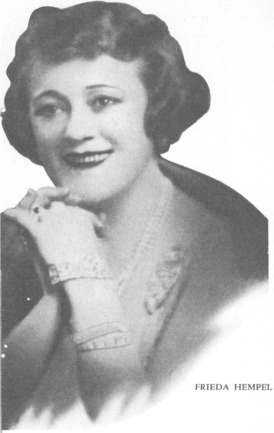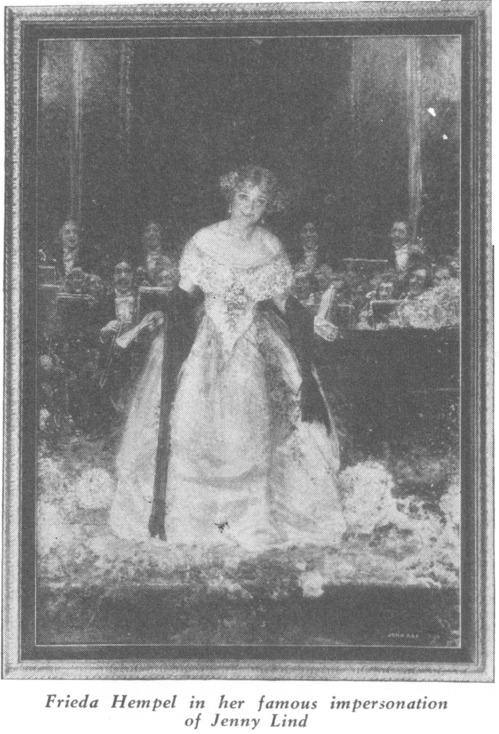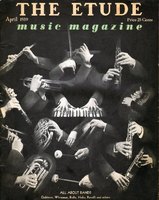A Conference Secured Expressly for The Etude Music Magazine
By ROSE HEYLBUT
IF I WERE ASKED to define the singer’s art, I should not explain it in terms of vocal technic. I should say that it lies in the ability to move an audience, in a worthy manner. That, to me, is the summing up of the meaning of art. You go to a concert and hear great songs performed by a great voice—and it may still happen that you come away bowed down by all your own troubles. You go to another concert, and hear the very same songs sung by a different voice, and you come away so buoyed in mood and lifted in spirit that your troubles cease to exist. You can move mountains, sheerly on the strength that concert has provided. The difference between those two reactions marks, not a quality of voice, but the power of the singers’ art. The singer who performs notes alone is merely a technician. But the singer who can face a hall full of listeners—of different ages, races, and temperaments—and lift them all to the same pitch of emotional release, such a singer is an artist.

How, then, shall the young singer set about making herself an artist? The first requisite can neither be taught nor learned. It must be inborn. We know that a person, who lacks a talent for drawing, never can become a great painter. In the matter of singing, we are less reasonable. Everybody has a voice; therefore, everybody ought to be able to sing, if only he is lucky enough to find the right teacher to show him the right “tricks.” Which, of course, is a profound mistake. Everyone has a voice, true enough, and can be taught to make that voice more agreeable. But a singing career requires a great and unusual voice. Thus, the first study in which the ambitious young singer should engage is the all important self-analysis which alone can indicate the direction of future work. Make sure your inborn gifts do not fall too far behind your ambitions. Then assure yourself that there are no “tricks.” Only conscientious work can build an art.
I have said that the measure of art is the power to move; and many qualities besides voice are necessary to project that power. Regardless of vocal discipline, the singer must build a picture in her own mind and send it out, into the minds and hearts of her hearers. At once, a great many activities come into play. She must create in her own mind the exact image she wants to project. She must feel it deeply enough to make it convincing. She must express it clearly enough for others to understand. In this sense, she sings not only with her voice, but also with her brain, her heart—with her whole body.
Art Is Simplicity
We talk much of specialization, of methods, of short cuts to fluency. We crowd our pupils’ minds with technical sounding problems, and lose sight of the fact that all this talk about singing leads us farther and farther away from singing itself. It is always a pity to let the trees block out one’s view of the forest. We need a return to simple, natural, fundamental singing.
The young singer should be given as little confusing theory about singing as possible. She should be permitted to sing. Only in this way will her personal problems reveal themselves—and no two singers have exactly the same problems to solve. The young singer should be trained to draw a perfectly natural breath and to release it naturally. Does that-sound too simple? It is the best foundation upon which to build. Let the problems be solved after they
have asserted themselves; do not anticipate them. A singer need not be troubled with complicated theories of breath support until it is shown that she needs special development along those lines.
The first year of study should be devoted entirely and exclusively to tone building. I cannot express that too emphatically. Tone building, and nothing else, is quite enough for that important first year. Each tone of the voice must be explored and made certain. The separate tones must be combined into a smooth scale which encompasses the entire range evenly, passing from low tones to the middle register, and thence to the upper tones, and all this without the least suspicion of a break. Nothing can take the place of full, even scales. Next, these tones must be taken in different values — staccato, sustained, spun out, in trills, in arpeggios. The perfection of these various values is the work of a lifetime. A single year, in the formative stage, is hardly too much to spend in concentration upon them. Complete songs should never be attempted before the second year of study; and then only the simplest songs! Not until the third year, when the tones are sure and “settled” enough to be carried over into songs and vocalises, should the student begin to work on arias. The first arias to study are the Italian ones. They are easier for the voice, and lay the foundations for greater finesse.
No Excellence Without Labor
Time is perhaps the chief ingredient of artistry. Studies must be not only acquired; they must be allowed to ripen, within one’s mind and within one’s throat. The saddest mistake a young singer can make is to try to work quickly. Indeed, it cannot be done! Let us make no mistake about this matter of learning. One can manage to sing a scale or an exercise inside of a week. But it has not been learned until it lies in the voice easily and naturally. The one who has studied a foreign language will appreciate the difference between mastering the individual words and putting them together in a full, spontaneous sentence. At the beginning, one must stop and think out each word, and he may utter those words quite correctly. But such a halting process is a very different matter from speaking the language. It is the same in singing. To know how to combine eight tones into a correct scale is a very different matter from having learned to sing scales. The tones must sit naturally in the voice. The technical disciplines must fall naturally into the tones. Only then can one speak of singing.
My own vocal production was always easy and natural. I had no special problems to trouble me, and I could have gone ahead very quickly—but I was not allowed to do so. For three long years I was kept at the study of tone building and technical drill. At sixteen, I was offered a part in opera; but it was necessary to refuse it while I was getting a reliable foundation in singing. At the time I regretted what seemed a crushing waste of years. To-day I am thankful for the discipline which built my voice into a sound organ, and which has kept it so. Even now I am as careful in my work as I was in my earliest student days.
I love my songs and learn them easily. After scanning a page of music for five minutes, I know it by heart. But I never sing a song in public until I have spent at least six months living with it, working at it, polishing it—taking it into my system until it becomes a natural part of me. On one occasion, this finishing process had interesting results. The late Roland Farley sent me his alluring Night Wind; and, after months of study, it seemed that the song could be improved by some slight changes, both in the accompaniment and the melody. I made my suggestions to Mr. Farley, and he kindly accepted them, saying that henceforth, Night Wind was my song.
The soundest advice I can offer the student of singing is, do not hurry! Be patient. Allow yourself time to take your art seriously. The student who accepts engagements within twenty months of study, will be finished and forgotten years before the careful artist is beginning to assert herself.
The life of the voice depends upon the thoroughness of early training, and upon constant exercise. There is no such thing as tiring a voice through singing, provided its production is natural and sound. The very fact that the voice becomes tired is an indication of incorrect singing methods. The well used voice is not only able to continue singing—it needs to sing. Imagine how your hair would look if you gave the scalp muscles a “little rest” from brushing. The voice fares no better. Every day, at all times and seasons, the singer should spend two hours working at scales, arpeggios, leaps, trills, sustained tones, spun tones. Practice may never cease. I spend two hours every day at my work, in half hour intervals exactly as I did during my first year at the Conservatory. It is my law. And my voice is the fresher for it.
The Soul of Song
But vocal ability alone is only one of the requirements of art. It is important as a means of expression. Equally important is the emotional value to be expressed. We call this “interpretation.” Actually, it is more than interpretation. It is the creation of a mood which lifts and moves one’s hearers. This must be an eminently personal thing. One can imitate “effects” (though it is an unwise procedure) but she cannot imitate emotional conviction. That is why great, warmth giving artists are rare. It is also why interpretation is so difficult to teach. When artists come to me for advice and study, I can tell in the first moment of their singing whether they actually feel the song deeply and sincerely enough to convince others. If their powers of conviction are not very strong, I never attempt to tell them what to do. Instead, I try, by examples, to stimulate a warmer feeling within them. Is it a lullaby that a young girl wishes to sing? I take her away from the music and the business of singing, and ask her if she has ever held a little child in her arms. Did she enjoy the experience? How did the baby look? What did it do? At once, the girl drops her “audition” self and becomes natural, telling me of some little sister, or niece, or friend.
“Now, don’t tell me any more,” I say. “Take everything you have in mind, and put it into your song.”
And immediately, the lullaby becomes warm and real and convincing. It ceases to be a “concert number”; it becomes a reality, a part of human life.
Again, take Schubert’s lovely “Ihr Bild.” Let the student get away from singing problems, and concentrate on the text. Has she ever looked long and yearningly at some picture—a picture, perhaps, of some loved one who has died? As she looks at this picture, has she never felt the sudden conviction that the beloved face has come to life and smiles in affection and encouragement? Let that personal experience, with its personal reactions, be the keynote for the mood of the song. When she plans her effects according to what they “ought to be,” they become artificial and cold. Only sincere emotion can reach the hearts of her hearers.
There must be an eminently personal bridge between the singer’s heart and the hearts of her audience. The notes of the music are merely the messengers who cross the bridge. Be as natural in your effects as you can. Do not stand stiffly on the stage, because someone has told you it is undignified to move your hands at a concert. Spend much time studying the inner, personal meaning of your songs, and then express it in the way that you think it should be expressed. There is no one right way! Each artist will express the same song differently—and that is why art remains alive. After one of my recitals, a friend who was ill and could not go, told me she had heard that, in one song, I had made a pretty effect with my hands. She wanted to know just what I had done. I was quite unable to tell her what I had done. I do not remember using my hands while singing, any more than I remember what I did with them when someone wished me “A Merry Christmas.” In each case, I did what came naturally, as the only spontaneous thing to do. Planned “effects” never move.
The Imponderable Lied
Lieder singing is an art quite by itself. It is difficult because it depends entirely upon the projection powers of the singer. There are no stage settings, no costumes, no buoying orchestra. One comes out upon the stage, and the entire effect to be made rests solely upon what one has to give. Further, lieder singing is intimate in style. Most of the songs are brief, and center around a mood or a feeling; and each requires the most sensitive kind of interpretation. We often find singers whose style and nature are too robust to lend themselves gracefully to this essentially sensitive type of music.
The first requisite for artistic lieder singing is imagination. Nearly every great lied either paints a picture or describes some personal emotion. The art of the singer lies in visualizing the picture, reliving the mood, and in sending both out across the footlights so convincingly that the listener in the farthest row will feel himself personally and intimately included. This is no slight task. One must have a thorough mastery of the mood and remain deeply imbued with it, in order to project so evanescent a thing through the length and breadth of a large public hall. Imagination must therefore be part of the singer’s inborn equipment; also, it must constantly be stimulated and refreshed, in the way that has been suggested.
The Approach to Study
Always begin the study of a song away from the music, working entirely from the text. Let the meaning and the beauty of the poem sink into your mind. Recite it, as a poem. You will be surprised, in working at a new song, to find that the natural lilt and emphasis of the words suggest the line of the melody. In Schumann’s Du bist wie eine Blume, the climax of adjectives, “so hold und schoen und rein” suggests a natural upswing of the voice, which is exactly provided in the music. Paint a picture with the words, and express it through the music. When the opening notes of the accompaniment are sounded, they should serve as the frame into which your picture mood must fit.
I see no harm in learning by imitation, provided that the models are worth imitating, and that the imitation does not become mechanical or slavish. Where could one find a better standard for the singing of the Caro nome than the record by Nellie Melba? But—do not try to be Melba! Use her interpretation as the basis upon which you may superimpose your own ideas. Naturally, you will not do as well as Melba. But you will bring something to your singing which is freshly and truly your own, and which will therefore be better than copying anybody.
Above all, work! Work with your brain and your heart, as well as with your voice. A New York critic recently wrote that the day may come when it will be no longer possible to present Mozart’s operas, because the present day singers lack the suavity of line and the polish necessary to do them full justice. That would be a dreadful day to which to look forward. There is no lack of fine vocal material. But vocal material alone is a long distance from worthy art. The great operas of pure bel canto—those of Mozart, Rossini, Bellini, and some of Verdi—lacked nothing when they were sung by artists of the stamp of Melba, Lilli Lehmann, Battistini, and the De Reszkes. And those artists, in their turn, devoted their entire lives to the perfection of their work. They did not merely coach parts for next week’s performance; they made musical history! It is regrettable that our own day, which has brought us such progress in making music accessible, should be contented with standards that are less splendid than those of the past. There is a reason for it, of course; an age of speed and spectacular successes makes it possible to go ahead on less than perfection; and, if this can be done, there is the inevitable temptation to do it. But the artist who is worthy of the name will not surrender to such temptations. She will continue to strive for perfection, for the sake of her own inner peace. The students of to-day will be the artists of to-morrow. It is to them that I appeal. Let the flame in the torch go on burning clearly. Only by honest hard work and honest sentiment can one succeed in moving the hearts of others.




